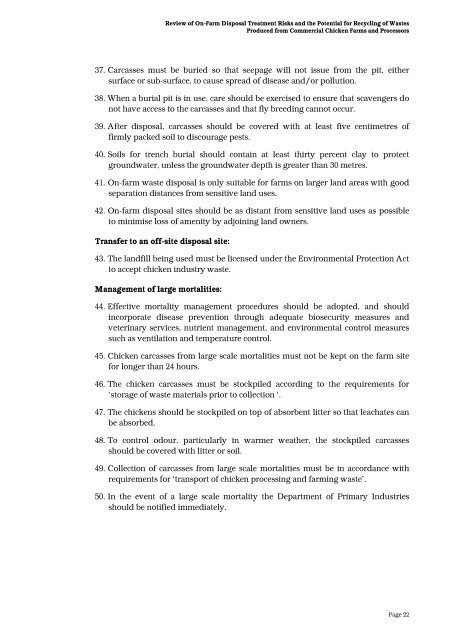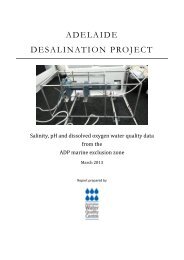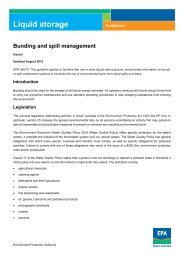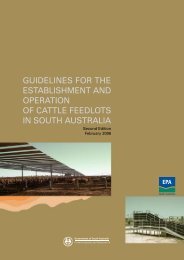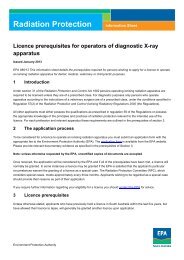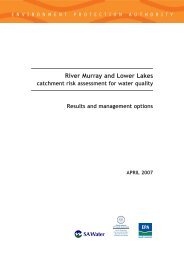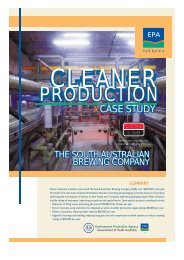Commercial Chicken Farms and Processors - EPA
Commercial Chicken Farms and Processors - EPA
Commercial Chicken Farms and Processors - EPA
You also want an ePaper? Increase the reach of your titles
YUMPU automatically turns print PDFs into web optimized ePapers that Google loves.
Review of On-Farm Disposal Treatment Risks <strong>and</strong> the Potential for Recycling of Wastes<br />
Produced from <strong>Commercial</strong> <strong>Chicken</strong> <strong>Farms</strong> <strong>and</strong> <strong>Processors</strong><br />
37. Carcasses must be buried so that seepage will not issue from the pit, either<br />
surface or sub-surface, to cause spread of disease <strong>and</strong>/or pollution.<br />
38. When a burial pit is in use, care should be exercised to ensure that scavengers do<br />
not have access to the carcasses <strong>and</strong> that fly breeding cannot occur.<br />
39. After disposal, carcasses should be covered with at least five centimetres of<br />
firmly packed soil to discourage pests.<br />
40. Soils for trench burial should contain at least thirty percent clay to protect<br />
groundwater, unless the groundwater depth is greater than 30 metres.<br />
41. On-farm waste disposal is only suitable for farms on larger l<strong>and</strong> areas with good<br />
separation distances from sensitive l<strong>and</strong> uses.<br />
42. On-farm disposal sites should be as distant from sensitive l<strong>and</strong> uses as possible<br />
to minimise loss of amenity by adjoining l<strong>and</strong> owners.<br />
Transfer to an off-site disposal site:<br />
43. The l<strong>and</strong>fill being used must be licensed under the Environmental Protection Act<br />
to accept chicken industry waste.<br />
Management of large mortalities:<br />
44. Effective mortality management procedures should be adopted, <strong>and</strong> should<br />
incorporate disease prevention through adequate biosecurity measures <strong>and</strong><br />
veterinary services, nutrient management, <strong>and</strong> environmental control measures<br />
such as ventilation <strong>and</strong> temperature control.<br />
45. <strong>Chicken</strong> carcasses from large scale mortalities must not be kept on the farm site<br />
for longer than 24 hours.<br />
46. The chicken carcasses must be stockpiled according to the requirements for<br />
‘storage of waste materials prior to collection ‘.<br />
47. The chickens should be stockpiled on top of absorbent litter so that leachates can<br />
be absorbed.<br />
48. To control odour, particularly in warmer weather, the stockpiled carcasses<br />
should be covered with litter or soil.<br />
49. Collection of carcasses from large scale mortalities must be in accordance with<br />
requirements for ‘transport of chicken processing <strong>and</strong> farming waste’.<br />
50. In the event of a large scale mortality the Department of Primary Industries<br />
should be notified immediately.<br />
Page 22


